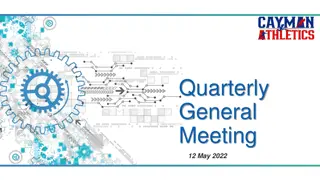
Differential Equations Fundamental Solutions and Theorems
Explore fundamental solutions, Wronskians, and linear independence in ordinary differential equations. Learn about differential operator notation, initial value problems, and unique solution theorems. Examples illustrate the concepts discussed.
Uploaded on | 0 Views
Download Presentation

Please find below an Image/Link to download the presentation.
The content on the website is provided AS IS for your information and personal use only. It may not be sold, licensed, or shared on other websites without obtaining consent from the author. If you encounter any issues during the download, it is possible that the publisher has removed the file from their server.
You are allowed to download the files provided on this website for personal or commercial use, subject to the condition that they are used lawfully. All files are the property of their respective owners.
The content on the website is provided AS IS for your information and personal use only. It may not be sold, licensed, or shared on other websites without obtaining consent from the author.
E N D
Presentation Transcript
Ordinary Differential Equations Fundamental Solution, Wronskians, and Linearly Independence Abadi Universitas Negeri Surabaya
Ch 3.2: Fundamental Solutions of Linear Homogeneous Equations Let p, q be continuous functions on an interval I = ( , ), which could be infinite. For any function y that is twice differentiable on I, define the differential operator L by y p y y L + = + q y Note that L[y] is a function on I, with output value ( ) ( ) ( p t y t y L + = + ) ( ) ( ) ( ) t y t q t y t For example, ( ) t ) = = = = 2 2 t ( ) , ( ) , ( ) sin( + ), 2 , 0 p t t q t e + y t t I y L = 2 2 t ( ) sin( ) cos( ) 2 sin( t t t t e
Differential Operator Notation In this section we will discuss the second order linear homogeneous equation L[y](t) = 0, along with initial conditions as indicated below: ) ( , ) ( y t y y t y = = = + + = ( ) ( ) 0 L y y p t y q t y 0 0 0 1 We would like to know if there are solutions to this initial value problem, and if so, are they unique. Also, we would like to know what can be said about the form and structure of solutions that might be helpful in finding solutions to particular problems. These questions are addressed in the theorems of this section.
Theorem 3.2.1 Consider the initial value problem + + = ( ) y ( ) ( ) y p = t y q t y = g t 0 ( ) , ( ) y t y t y 0 0 0 where p, q, and g are continuous on an open interval I that contains t0. Then there exists a unique solution y = (t) on I. Note: While this theorem says that a solution to the initial value problem above exists, it is often not possible to write down a useful expression for the solution. This is a major difference between first and second order linear equations.
Example 1 Consider the second order linear initial value problem ( ) 0 , 0 = = y y y ( ) 1 0 = , 3 y In Section 3.1, we showed that this initial value problem had the following solution: t t e e t y + = 2 ) ( Note that p(t) = 0, q(t) = -1, g(t) = 0 are each continuous on (- , ), and the solution y is defined and twice differentiable on (- , ).
Example 2 Consider the second order linear initial value problem , 0 ) ( ) ( = + + y t q y t p y ( ) 0 ( ) 0 = = , 0 0 y y where p, q are continuous on an open interval I containing t0. In light of the initial conditions, note that y = 0 is a solution to this homogeneous initial value problem. Since the hypotheses of Theorem 3.2.1 are satisfied, it follows that y = 0 is the only solution of this problem.
Example 3 Determine the longest interval on which the given initial value problem is certain to have a unique twice differentiable solution. Do not attempt to find the solution. ( ) , 1 3 ) (cos 1 = + + y y t y t ( ) 0 ( ) 0 = = , 1 0 y y First put differential equation into standard form: 3 1 + + t t cos 1 + t ( ) 0 ( ) 0 y + = = = , , 1 0 y y y y 1 1 t The longest interval containing the point t = 0 on which the coefficient functions are continuous is (-1, ). It follows from Theorem 3.2.1 that the longest interval on which this initial value problem is certain to have a twice differentiable solution is also (-1, ).
Theorem 3.2.2 (Principle of Superposition) If y1and y2are solutions to the equation ] [ + = p y y L + = ( ) ( ) 0 t y q t y then the linear combination c1y1+ y2c2is also a solution, for all constants c1and c2. To prove this theorem, substitute c1y1+ y2c2in for y in the equation above, and use the fact that y1and y2 are solutions. Thus for any two solutions y1 and y2, we can construct an infinite family of solutions, each of the form y = c1y1 + c2 y2. Can all solutions can be written this way, or do some solutions have a different form altogether? To answer this question, we use the Wronskian determinant.
The Wronskian Determinant (1 of 3) Suppose y1and y2are solutions to the equation ) ( ] [ + = y t p y y L + = ( ) 0 q t y From Theorem 3.2.2, we know that y = c1y1+ c2 y2is a solution to this equation. Next, find coefficients such that y = c1y1+ c2 y2 satisfies the initial conditions ) ( , ) ( t y y t y = = 0 y 0 0 0 To do so, we need to solve the following equations: 2 0 1 1 ) ( c t y c + + = ( ) ( ) c y t c y t y 2 0 0 2 0 = ( ) y t y 1 1 0 2 0
The Wronskian Determinant (2 of 3) Solving the equations, we obtain = ( ) ( ) y y t y y t 0 2 0 0 2 0 y c 1 ( ) y ( ) ( ) ( ) y t y t y t t 1 0 2 y 0 1 y 0 y 2 0 1 0 + ( t ) ( ) t t = 0 y 0 1 0 c 2 2 1 ( ) ( ) ( ) ( ) y t y t y t 1 0 0 0 2 0 In terms of determinants: y y = ( ) ( ) t y t y 0 2 0 1 0 0 2 ( ) t ( ) y y t y t y = 0 t 0 1 t 0 0 t , c c 1 2 ( ) ( ) ( ) ( ) y y y y 1 0 2 0 1 0 2 0 1 2 1 2 ( ) ( ) ( ) ( ) y t y t y t y t 0 0 0 0
The Wronskian Determinant (3 of 3) In order for these formulas to be valid, the determinant W in the denominator cannot be zero: t y y 0 2 0 ) ( = = ( ) ( ) y t y 1 0 0 0 2 1 0 ( ) y y t y t y 0 0 , c c 1 2 W W ( ) ( ) y t y t 2 1 1 0 2 0 = = ( ) ( ) ( ) ( ) W y t y t y t y t 1 2 1 0 0 0 2 0 ( ) ( ) y t y t 0 0 W is called the Wronskian determinant, or more simply, the Wronskian of the solutions y1and y2. We will sometimes use the notation ( )( ) 2 y y W 1, t 0
Theorem 3.2.3 Suppose y1 and y2are solutions to the equation ) ( ] [ + + = y t p y y L = ( ) 0 ) 1 ( q t y and that the Wronskian W = 2 1 y y y y 1 2 is not zero at the point t0 where the initial conditions ( , ) ( 0 0 t y y t y = 0 = ) ) 2 ( y 0 are assigned. Then there is a choice of constants c1, c2for which y = c1y1+ c2 y2is a solution to the differential equation (1) and initial conditions (2).
Example 4 Recall the following initial value problem and its solution: ( ) ( ) y y y y = = 0 , 3 0 , 0 = = + t t 1 ( ) 2 y t e e Note that the two functions below are solutions to the differential equation: t t e y e y = = 2 1 , The Wronskian of y1 and y2is = y y y y 2 1 1 2 = = = = 0 t t t t 2 2 W y y y y e e e e e 1 2 1 2 Since W 0 for all t, linear combinations of y1 and y2can be used to construct solutions of the IVP for any initial value t0. 1 1 y c y + = c y 2 2
Theorem 3.2.4 (Fundamental Solutions) Suppose y1 and y2are solutions to the equation ) ( ] [ + = y t p y y L + = ( ) . 0 q t y If there is a point t0 such that W(y1,y2)(t0) 0, then the family of solutions y = c1y1+ c2 y2with arbitrary coefficients c1, c2includes every solution to the differential equation. The expression y = c1y1+ c2 y2is called the general solution of the differential equation above, and in this case y1and y2are said to form a fundamental set of solutions to the differential equation.
Example 5 Recall the equation below, with the two solutions indicated: t e y y y = = 1 , , 0 = t y e 2 The Wronskian of y1 and y2is y y W = 1 2 = = = 0 t t t t 2 2 for 0 all . t e e e e e y y 1 2 Thus y1 and y2form a fundamental set of solutions to the differential equation above, and can be used to construct all of its solutions. The general solution is c y = + t t e c e 1 2
Example 6 Consider the general second order linear equation below, with the two solutions indicated: 0 ) ( ) ( = + + y t q y t p y Suppose the functions below are solutions to this equation: , , r e y e y = = t r r t r 1 2 1 2 1 2 The Wronskian of y1and y2is y y W = t r r t e e 1 2 ( ) ( ) + 1 2 = = r r t for 0 all . t r r e 1 2 2 1 t r r t y y r e r e 1 2 1 2 1 2 Thus y1and y2form a fundamental set of solutions to the equation, and can be used to construct all of its solutions. The general solution is r t r e c e c y 2 1 + = t 1 2
Example 7: Solutions (1 of 2) Consider the following differential equation: , 0 3 2 = + y y t y t 2 0 t Show that the functions below are fundamental solutions: 1 2 1 , = = t y t y / 1 2 To show this, first substitute y1into the equation: 2 / 1 2 / 3 2 1 3 t t + = + = / 1 t 2 / 1 t 2 2 3 1 0 t t 4 2 2 2 Thus y1is a indeed a solution of the differential equation. Similarly, y2is also a solution: ( ( 3 2 2 = + t t t t t ) ( ) ) = 2 3 2 1 1 4 3 1 0 t
Example 7: Fundamental Solutions (2 of 2) Recall that = = / 1 t 2 1 , y y t 1 2 To show that y1 and y2form a fundamental set of solutions, we evaluate the Wronskian of y1 and y2: / 1 t 2 1 t y y 1 3 3 / 3 / 3 / 3 1 2 = = = = = 2 2 2 1 W t t t / 1 2 2 t t 1 2 y y 2 2 3 2 t 2 Since W 0 for t > 0, y1, y2form a fundamental set of solutions for the differential equation y + = 2 2 3 , 0 0 t t y y t
Theorem 3.2.5: Existence of Fundamental Set of Solutions Consider the differential equation below, whose coefficients p and q are continuous on some open interval I: ) ( ] [ + + = q y t p y y L = ( ) 0 t y Let t0 be a point in I, and y1and y2solutions of the equation with y1satisfying initial conditions ( , 1 ) ( 0 1 0 1 = t y t y = ) 0 and y2satisfying initial conditions ) ( 0 2 t y 2 = = , 0 ( ) 1 y t 0 Then y1, y2form a fundamental set of solutions to the given differential equation.
Example 7: Theorem 3.2.5 (1 of 3) Find the fundamental set specified by Theorem 3.2.5 for the differential equation and initial point 0 , 0 = t y y 0= We showed previously that y = 1 = t t , e y e 2 were fundamental solutions, since W(y1, y2)(t0) = -2 0. But these two solutions don t satisfy the initial conditions stated in Theorem 3.2.5, and thus they do not form the fundamental set of solutions mentioned in that theorem. Let y3 and y4be the fundamental solutions of Thm 3.2.5. ) 0 ( ; 0 ) 0 ( , 1 ) 0 ( 4 3 3 = = y y y ) 0 ( 4 = = , 0 1 y
Example 7: General Solution (2 of 3) Since y1 and y2form a fundamental set of solutions, ) 0 ( , 3 2 1 3 + = y e d e d y ) 0 ( 3 y = + = = t t , 1 = 0 y c e c e y y ) 0 ( 4 = t t , ) 0 ( 4 , 0 1 4 1 2 Solving each equation, we obtain 1 2 1 1 1 = + = = = t t t t ( ) cosh( ), ( ) sinh( ) y t e e t y t e e t 3 4 2 2 2 The Wronskian of y3 and y4is cosh sinh y y t t 1 2 = = = = 2 2 cosh sinh 1 0 W t t 1 2 sinh cosh y y t t Thus y3, y4forms the fundamental set of solutions indicated in Theorem 3.2.5, with general solution in this case ) cosh( ) ( 1 k t k t y + = sinh( ) t 2
Example 7: Many Fundamental Solution Sets (3 of 3) Thus S e e S cosh , , 2 1 = = t t t , sinh t both form fundamental solution sets to the differential equation and initial point t y y = 0= , 0 0 In general, a differential equation will have infinitely many different fundamental solution sets. Typically, we pick the one that is most convenient or useful.
Summary To find a general solution of the differential equation = + + y t q y t p y ) ( ) ( , 0 t we first find two solutions y1 and y2. Then make sure there is a point t0 in the interval such that W(y1, y2)(t0) 0. It follows that y1and y2form a fundamental set of solutions to the equation, with general solution y = c1y1+ c2 y2. If initial conditions are prescribed at a point t0 in the interval where W 0, then c1 and c2can be chosen to satisfy those conditions.
Ch 3.3: Linear Independence and the Wronskian Two functions f and g are linearly dependent if there exist constants c1and c2, not both zero, such that ) ( ) ( 2 1 = + t g c t f c 0 for all t in I. Note that this reduces to determining whether f and g are multiples of each other. If the only solution to this equation is c1= c2= 0, then f and g are linearly independent. For example, let f(x) = sin2x and g(x) = sinxcosx, and consider the linear combination cos sin 2 sin 2 1 + x c x c = 0 x This equation is satisfied if we choose c1= 1, c2= -2, and hence f and g are linearly dependent.
Solutions of 2 x 2 Systems of Equations When solving c 1 + = x c x a 1 2 2 + = c y c y b 1 1 2 2 for c1and c2, it can be shown that 2 2 2 1 x y y x = ay bx ay bx = = 2 , c D 1 2 1 bx 2 x x + + ay ay bx 1 2 = = 1 1 1 D 1 , where c D 2 y y x y y x 1 2 1 2 1 2 Note that if a = b = 0, then the only solution to this system of equations is c1= c2= 0, provided D 0.
Example 1: Linear Independence (1 of 2) Show that the following two functions are linearly independent on any interval: = ( , ) ( = t t ) f t e g t e Let c1and c2be scalars, and suppose ) ( 1 + t f c = ( ) 0 c g t 2 for all t in an arbitrary interval ( , ). We want to show c1= c2= 0. Since the equation holds for all t in ( , ), choose t0 and t1 in ( , ), where t0 t1. Then 1 + e c + = t t 0 c e c e 0 0 2 = t t 0 c e 1 1 1 2
Example 1: Linear Independence (2 of 2) The solution to our system of equations + e c e c = t t 0 0 0 1 2 + = t t 0 c e c e 1 1 1 2 will be c1= c2= 0, provided the determinant D is nonzero: 0 0 t t t t e e e e e t t e e = = = t t t t t t D e e e 0 0 0 1 1 0 1 1 1 1 ( ) Then D 1 2 = = = = t t t t t t t t 0 1 e e e e 0 1 1 0 0 1 0 1 t t e 0 1 = = t t 1 e t t 0 1 0 1 Since t0 t1, it follows that D 0, and therefore f and g are linearly independent.
Theorem 3.3.1 If f and g are differentiable functions on an open interval I and if W(f, g)(t0) 0 for some point t0in I, then f and g are linearly independent on I. Moreover, if f and g are linearly dependent on I, then W(f, g)(t) = 0 for all t in I. Proof (outline): Let c1and c2be scalars, and suppose ( ) ( 2 1 + g c t f c = ) 0 t for all t in I. In particular, when t = t0we have ( ) ( 2 0 1 + g c t f c + = ) 0 c f t c g t 0 t = ( ) ( ) 0 1 0 2 0 Since W(f, g)(t0) 0, it follows that c1= c2= 0, and hence f and g are linearly independent.
Theorem 3.3.2 (Abels Theorem) Suppose y1 and y2 are solutions to the equation ) ( ] [ + = y t p y y L + = ( ) 0 q t y where p and q are continuous on some open interval I. Then W(y1,y2)(t) is given by = t y y W 2 1 ) )( , ( ( ) p t dt ce where c is a constant that depends on y1 and y2 but not on t. Note that W(y1,y2)(t) is either zero for all t in I (if c = 0) or else is never zero in I (if c 0).
Example 2: Wronskian and Abels Theorem Recall the following equation and two of its solutions: y e y y y = = 2 1 , , 0 = t t e The Wronskian of y1and y2 is y y W 1 2 = = = = 0 t t t t 2 2 for 0 all . t e e e e e y y 1 2 Thus y1 and y2 are linearly independent on any interval I, by Theorem 3.3.1. Now compare Wwith Abel s Theorem: = 2 1 ) )( , ( ( ) 0 p t dt dt = = W y y t ce ce c Choosing c = -2, we get the same W as above.
Theorem 3.3.3 Suppose y1 and y2 are solutions to equation below, whose coefficients p and q are continuous on some open interval I: ) ( ] [ + + = y t p y y L = ( ) 0 q t y Then y1 and y2 are linearly dependent on I iff W(y1, y2)(t) = 0 for all t in I. Also, y1 and y2 are linearly independent on I iff W(y1, y2)(t) 0 for all t in I.
Summary Let y1 and y2 be solutions of + y + = ( ) ( ) 0 p t y q t y where p and q are continuous on an open interval I. Then the following statements are equivalent: The functions y1 and y2 form a fundamental set of solutions on I. The functions y1 and y2 are linearly independent on I. W(y1,y2)(t0) 0 for some t0 in I. W(y1,y2)(t) 0 for all t in I.
Linear Algebra Note Let V be the set ( , ) y = + + = : ( ) ( ) , 0 V y p t y q t y t Then V is a vector space of dimension two, whose bases are given by any fundamental set of solutions y1 and y2. For example, the solution space V to the differential equation 0 = y y t = = has bases t t , , cosh , sinh S e e S t 1 2 with = = Span Span V S S 1 2






















